
Availability of premium gianduia spreads in the United States has increased dramatically over the past several years, making it much easier to find products of acceptable quality.
Because gianduia spreads are jarred, they have a longer shelf life than gianduiotti, making them more attractive for importers and retailers. Also, to the extent Americans have any concept of gianduia at all, it’s in the feeble guise of Nutella. Many customers recognize the appeal of something Nutella-like, but better.
 Like gianduiotti, premium gianduia spreads are not widely available in the United States, mostly appearing in quality import shops, Italian markets, and through online fine chocolate retailers. All of the spreads below have been available in the United States in the past three years, though some only sporadically.
Like gianduiotti, premium gianduia spreads are not widely available in the United States, mostly appearing in quality import shops, Italian markets, and through online fine chocolate retailers. All of the spreads below have been available in the United States in the past three years, though some only sporadically.
In several cases, the makers have changed recipes and packaging in that time. Gianduia spreads are a relatively young product (compared to gianduia itself), so it’s not unusual for makers to revamp in order to better compete. Review ingredient lists in light of the guidelines previously discussed to improve your odds of a good purchase.
In these ratings, each spread (except one) received a score from one to three stars, three being the best. Though there’s a significant quality gap between the worst and best of these spreads, all (except one) are superior to Nutella in flavor and aroma. The sample size for each spread (except one) exceeded 16 ounces, often several times over. Let’s start with that exceptional one—the one spread that made Nutella look good.
Zero Stars.
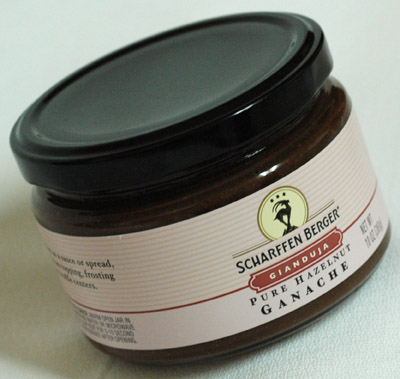 Scharffen Berger, Gianduja (Pure Hazelnut Ganache) (1). Scharffen Berger dabbled unsuccessfully in gianduia before Hershey’s Artisan Confections purchased the company in 2005, but this spread—part of a small line of jarred ganaches—came after the acquisition. The ingredient list raises a number of red flags. It leads with sugar. The spread has very low hazelnut content (the fourth item on the ingredient list), and not Tonda Gentile delle Langhe. In addition to the sugar, it’s sweetened with corn syrup. In keeping with labeling the product as ganache, Scharffen Berger used half-and-half, instead of milk powder.
Scharffen Berger, Gianduja (Pure Hazelnut Ganache) (1). Scharffen Berger dabbled unsuccessfully in gianduia before Hershey’s Artisan Confections purchased the company in 2005, but this spread—part of a small line of jarred ganaches—came after the acquisition. The ingredient list raises a number of red flags. It leads with sugar. The spread has very low hazelnut content (the fourth item on the ingredient list), and not Tonda Gentile delle Langhe. In addition to the sugar, it’s sweetened with corn syrup. In keeping with labeling the product as ganache, Scharffen Berger used half-and-half, instead of milk powder.
Scharffen Berger’s spread scores a zero. It’s dense, grainy, and sickly sweet. The sour, ammoniac smell bears no relation to gianduia. Think rancid chocolate Play-Doh. Absolutely inedible.
Scharffen Berger’s spread constitutes one of the greatest crimes committed in the name of “gianduia.” Regrettably, there’s no statute of limitations on the offense. The jars left the factory with no expiration date. The product was discontinued some time before Hershey closed Scharffen Berger’s quaint Berkeley factory in the spring of 2009 and moved all production to Robinson, Illinois. Because the jars have no “sell by” date, they still turn up on shelves occasionally. Though the jar sampled for this article was purchased in 2008, it’s fair to assume that the spread has not improved with age. Should you come across this product, do not buy it.
One Star (★).
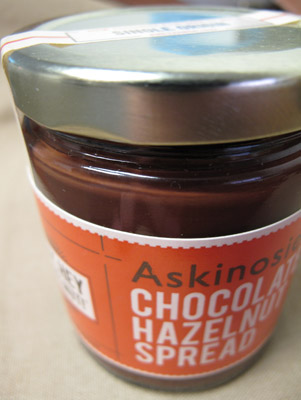 ★ Askinosie Chocolate, “Hey, Hey, Hazelnut!” Chocolate Hazelnut Spread (2). Shawn Askinosie is one of the good guys in the chocolate world, an American craft bean-to-bar maker of seriousness and integrity. His chocolate hazelnut spread has a lot going for it on paper. It’s a “bean-to-jar” product using quality single-origin (Philippines) cocoa powder of Askinosie’s own pressing. The ingredient list leads with hazelnuts, with sugar coming in third place. There are no extraneous fats, artificial flavors, milk solids, or even vanilla. It’s the shortest, purest ingredient list of any commercially produced gianduia spread I’ve seen.
★ Askinosie Chocolate, “Hey, Hey, Hazelnut!” Chocolate Hazelnut Spread (2). Shawn Askinosie is one of the good guys in the chocolate world, an American craft bean-to-bar maker of seriousness and integrity. His chocolate hazelnut spread has a lot going for it on paper. It’s a “bean-to-jar” product using quality single-origin (Philippines) cocoa powder of Askinosie’s own pressing. The ingredient list leads with hazelnuts, with sugar coming in third place. There are no extraneous fats, artificial flavors, milk solids, or even vanilla. It’s the shortest, purest ingredient list of any commercially produced gianduia spread I’ve seen.
As a dark chocolate spread, it succeeds nicely. More of a dense paste than a cream, it is firm, but spreadable with a little effort. The chocolate flavor comes on boldly and intensely, with the prominent acidity and noticeable astringency of Askinosie’s Davao bar (from the same cacao).
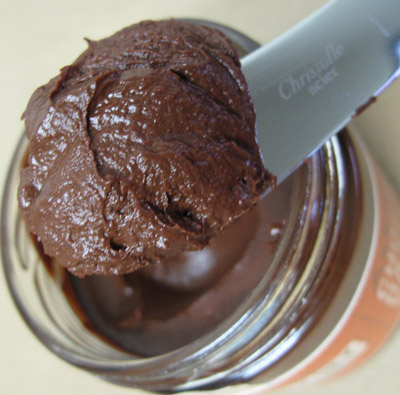
Askinosie “Hey, Hey, Hazelnut”
But, as gianduia, the hazelnuts bring this one up short. Askinosie uses DuChilly hazelnuts from Washington. DuChilly, more commonly known as Kentish Cob or Lunga di Spagna, is an English hazelnut cultivar that is somewhat sweeter than Barcelona (the most common hazelnut cultivar in the Pacific Northwest), but lower in oil, negatively impacting aroma and pellicle removability after roasting (3).
Though the hazelnut content is not disclosed on the ingredient list, Shawn Askinosie confirms in correspondence that the spread contains a minimum of 20%. The relatively low hazelnut content and the limitations of the cultivar result in a flat, woody backdrop to the intense cacao flavor. Though not unpleasant on its own terms, it doesn’t hit the mark for good gianduia.
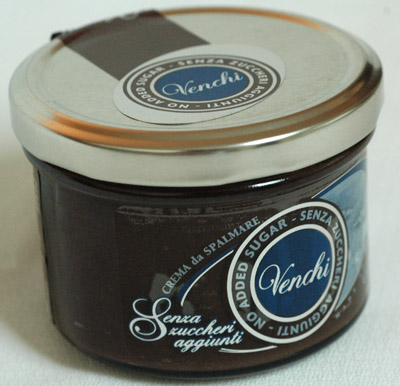 ★ Venchi, Crema da Spalmare (Senza Zuccheri Aggiunti) (4). Followers of this series will be familiar with Venchi, a storied name in Piedmontese confectionery. This is one of very few sugar-free premium gianduia spreads (if that’s not an oxymoron), relying on maltitol as the sole sweetener. While better than Nutella due to more chocolate-forwardness, slightly higher hazelnut content (16%), and the use of Tonda Gentile delle Langhe, the maltitol undercuts those advantages. Absent a medical need to avoid sugar, there’s no reason to purchase this spread, given the many better options on the market.
★ Venchi, Crema da Spalmare (Senza Zuccheri Aggiunti) (4). Followers of this series will be familiar with Venchi, a storied name in Piedmontese confectionery. This is one of very few sugar-free premium gianduia spreads (if that’s not an oxymoron), relying on maltitol as the sole sweetener. While better than Nutella due to more chocolate-forwardness, slightly higher hazelnut content (16%), and the use of Tonda Gentile delle Langhe, the maltitol undercuts those advantages. Absent a medical need to avoid sugar, there’s no reason to purchase this spread, given the many better options on the market.
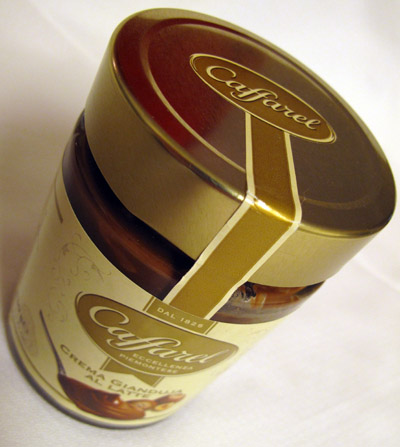 ★ Caffarel, Crema Gianduja al Latte (5). The oldest extant name in Piedmontese chocolate, Caffarel has passed through several changes in ownership, culminating in acquisition by the Swiss company Lindt & Sprüngli in 1997. Despite Swiss ownership, Caffarel continues to operate in Piedmont—specifically, in Luserna San Giovanni, Paul Caffarel’s birthplace in the Waldensian Val Pellice, to which the company relocated from Turin in 1968.
★ Caffarel, Crema Gianduja al Latte (5). The oldest extant name in Piedmontese chocolate, Caffarel has passed through several changes in ownership, culminating in acquisition by the Swiss company Lindt & Sprüngli in 1997. Despite Swiss ownership, Caffarel continues to operate in Piedmont—specifically, in Luserna San Giovanni, Paul Caffarel’s birthplace in the Waldensian Val Pellice, to which the company relocated from Turin in 1968.
This spread poorly serves Caffarel’s reputation. Everything about the ingredient list indicates an effort to beat Nutella by a nose, rather than trouncing her. It leads with sugar, relies on extraneous fats (peanut oil) and artificial flavors (vanillin), and the hazelnut content (non-TGL) only reaches 14%, compared with Nutella’s standard 13%. The spread is overly sweet, with strong sugar pull in the texture, but better hazelnut aroma than Ferrero’s. Though better than Nutella, the improvement falls short of justifying the price premium.
Happily, Caffarel discontinued this product within the last year, replacing it with something far better—an encouraging sign of positive competitive pressure for premium gianduia spreads. Because of the relatively long shelf life of gianduia spreads, this lesser version can still be found in some gourmet and Italian markets today.
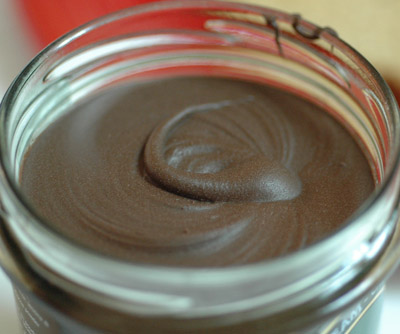
Venchi, Crema di Cacao
★ Venchi, Crema di Cacao (6). This Venchi spread also falls into the category of “discontinued, but still in circulation.” Venchi improves on Nutella with Tonda Gentile delle Langhe hazelnuts, higher cacao content, and natural vanilla. It’s held back, by heavy sugar, extraneous vegetable oil, and hazelnut content that matches Nutella’s 13%. Despite superficial ingredient similarities, this is no Nutella clone. The dense paste spreads like cold butter. The color is dark matte brown, with no oily gloss. Pronounced chocolate flavor offsets the high sugar content. Though a step up from Nutella, the low hazelnut content keeps this Venchi spread from achieving the traditional balance of gianduia and better gianduia spreads.
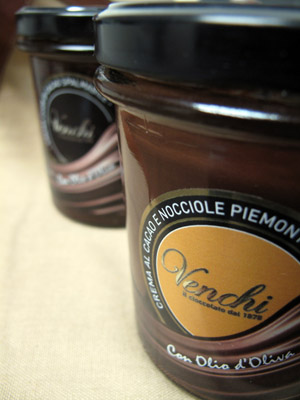
★ Venchi, Crema al Cacao e Nocciole (7). Venchi replaced the discontinued Crema di Cacao with this spread. It does improve on its predecessor, though only slightly. Instead of the former 13%, Venchi bumps the hazelnut content up to 17%. Despite Venchi’s use of TGL, the hazelnut content remains rather anemic—no match for the high sugar content and chocolate-forwardness. Venchi made one substantial and puzzling change in the formula, replacing the unspecified extraneous vegetable oil in the old spread with olive oil in this one. The olive oil content equals the hazelnut content, noticeably muddying the aroma and veering away from traditional gianduia flavor. While not a disastrous failure, this experiment should be recognized (both by Venchi and competitors) as the mistake that it is.
Two Stars (★★).
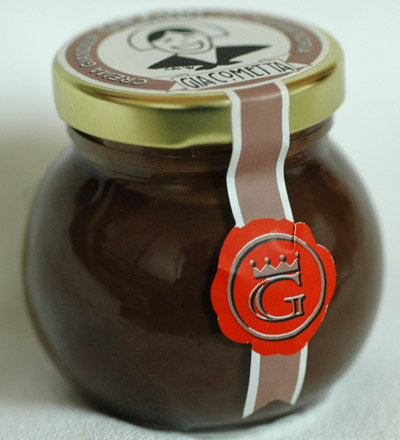 ★★ Giraudi, Giacometta (8). Giraudi is a small industrial confectioner located just east of the Langhe in Castellazzo Bormida (Piedmont). This milk chocolate gianduia spread takes its name from that of the character Gianduia’s wife, Giacômëtta. The ingredient list lacks in several ways, leading with sugar, relying on peanut oil, using vanillin instead of vanilla, and adding a small quantity of almonds (without the historical wiggle room afforded Caffarel).
★★ Giraudi, Giacometta (8). Giraudi is a small industrial confectioner located just east of the Langhe in Castellazzo Bormida (Piedmont). This milk chocolate gianduia spread takes its name from that of the character Gianduia’s wife, Giacômëtta. The ingredient list lacks in several ways, leading with sugar, relying on peanut oil, using vanillin instead of vanilla, and adding a small quantity of almonds (without the historical wiggle room afforded Caffarel).
Despite the compromises, the Tonda Gentile delle Langhe hazelnut content (32%) redeems the product. Opening the jar immediately releases the familiar, sweet aroma of Piedmont hazelnuts. The combination of hazelnut and peanut oil makes it one of the less viscous spreads on the market, with near-fluid consistency at room temperature. (Not a problem if you’re eating it with a spoon, though it can get messy on hot toast.) Despite high sugar content, Giraudi maintains very traditional milk chocolate gianduia flavor proportions. Though the least of the two-star spreads, it blows Nutella’s doors clean off.
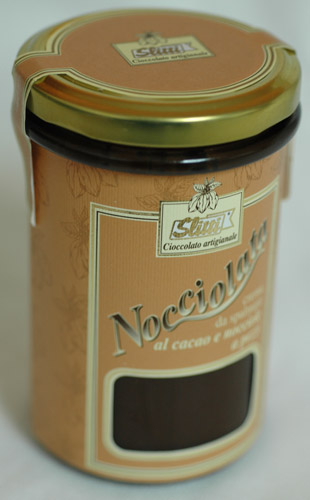 ★★ Slitti, Nocciolata (9). This small second-generation Tuscan company pioneered the current wave of premium gianduia spreads with Slittosa (a milk-chocolate spread) and Nocciolata. Nocciolata earns a few demerits with high sugar content, extraneous vegetable fat, and vanillin. The strong Tonda Gentile delle Langhe hazelnut content (35%) goes a long ways towards covering those faults. The balance of hazelnut and milk chocolate is appropriate and, though sweet, the spread is not cloying. Slitti’s Nocciolata runs fluid, more like a sauce than a spread. Also, unlike most other gianduia spreads, this one includes finely chopped roasted hazelnuts for textural contrast. Though Slitti’s more recent spreads surpass this, Nocciolata remains a fine premium gianduia spread.
★★ Slitti, Nocciolata (9). This small second-generation Tuscan company pioneered the current wave of premium gianduia spreads with Slittosa (a milk-chocolate spread) and Nocciolata. Nocciolata earns a few demerits with high sugar content, extraneous vegetable fat, and vanillin. The strong Tonda Gentile delle Langhe hazelnut content (35%) goes a long ways towards covering those faults. The balance of hazelnut and milk chocolate is appropriate and, though sweet, the spread is not cloying. Slitti’s Nocciolata runs fluid, more like a sauce than a spread. Also, unlike most other gianduia spreads, this one includes finely chopped roasted hazelnuts for textural contrast. Though Slitti’s more recent spreads surpass this, Nocciolata remains a fine premium gianduia spread.
 ★★ Domori, Crema Gianduja (10). Gianluca Franzoni’s company, located in None (Piedmont), developed an international reputation for quality on the basis of single-origin bean-to-bar dark chocolate. After Gruppo Illy acquired a majority stake in Domori in 2006, the company began expanding the line from dark chocolate bars to include more “value added” products such as flavored bars, “energy” bars, cross-promotion bundles with other Illy wares, and, recently, gianduiotti and this Crema Gianduja.
★★ Domori, Crema Gianduja (10). Gianluca Franzoni’s company, located in None (Piedmont), developed an international reputation for quality on the basis of single-origin bean-to-bar dark chocolate. After Gruppo Illy acquired a majority stake in Domori in 2006, the company began expanding the line from dark chocolate bars to include more “value added” products such as flavored bars, “energy” bars, cross-promotion bundles with other Illy wares, and, recently, gianduiotti and this Crema Gianduja.
Domori’s ingredient list is impressive, with high hazelnut content at 50% (using Tonda Gentile delle Langhe), no milk, no artificial flavors, and no extraneous fats. However, as with Domori’s somewhat disappointing gianduiotti (discussed in Part 29), the high combined hazelnut and sugar content are out of proportion with the cacao. This skews the flavor profile away from chocolate—which one would expect to be Domori’s strength—resulting in something closer to sweetened hazelnut butter than gianduia. Even so, the spread deserves recommendation (except for customers wanting a more chocolate-forward gianduia spread).
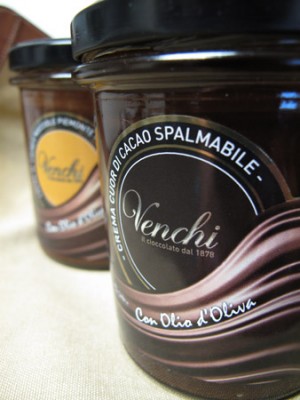 ★★ Venchi, Crema Cuor di Cacao (11). Within the past year, this spread replaced another Venchi product by the same name, though the older version doesn’t seem to be floating around anymore (12). In both iterations, Venchi made this an intense, dark chocolate gianduia spread. As with the milk chocolate revamp, Venchi added olive oil this time around, though it’s less noticeable here. Only Askinosie’s “Hey, Hey, Hazelnut” rivals Cuor di Cacao for chocolate-forwardness, though Venchi’s cacao lacks character and interest, offering little more than a flat, bitter, heavily roasted flavor. Darker than even the darkest gianduiotti, this is a spread for those who want chocolate front and center.
★★ Venchi, Crema Cuor di Cacao (11). Within the past year, this spread replaced another Venchi product by the same name, though the older version doesn’t seem to be floating around anymore (12). In both iterations, Venchi made this an intense, dark chocolate gianduia spread. As with the milk chocolate revamp, Venchi added olive oil this time around, though it’s less noticeable here. Only Askinosie’s “Hey, Hey, Hazelnut” rivals Cuor di Cacao for chocolate-forwardness, though Venchi’s cacao lacks character and interest, offering little more than a flat, bitter, heavily roasted flavor. Darker than even the darkest gianduiotti, this is a spread for those who want chocolate front and center.
While Venchi upgraded their milk chocolate gianduia spread with a slight bump in hazelnut content, they gutted Cuor di Cacao in the reboot. The prior version boasted 40% Tonda Gentile delle Langhe hazelnut content. It’s now 23%. This mutes the hazelnut flavor, naturally. It also knocks hazelnuts from primacy of place in the ingredient list, pushing sugar to the fore. The cacao’s intensity wards off perceived over-sweetness, but the high sugar content destroys the texture, creating severe tackiness and sugar pull. Even diminished by Venchi’s misguided reformulation, Cuor di Cacao continues to be a good gianduia spread.
 ★★ Baratti & Milano, Crema alle Nocciole (13). Also, Novi, CremaNovi. (14). Though Baratti & Milano’s roots lie in 19th century Turin, Gruppo Elah-Dufour (headquartered in Novi Ligure, Piedmont) bought the company a little over a decade ago. Elah-Dufour also owns the Piedmontese brand Novi. Apart from branding and container graphics, Baratti & Milano’s Crema alle Nocciole and Novi’s CremaNovi are indiscernible and have an identical ingredient list.
★★ Baratti & Milano, Crema alle Nocciole (13). Also, Novi, CremaNovi. (14). Though Baratti & Milano’s roots lie in 19th century Turin, Gruppo Elah-Dufour (headquartered in Novi Ligure, Piedmont) bought the company a little over a decade ago. Elah-Dufour also owns the Piedmontese brand Novi. Apart from branding and container graphics, Baratti & Milano’s Crema alle Nocciole and Novi’s CremaNovi are indiscernible and have an identical ingredient list.
As industrial products, Baratti & Milano’s Crema alle Nocciole and Novi’s CremaNovi show some compromise in the use of artificial flavoring (not disclosed, though almost certainly vanillin) and non-Tonda Gentile delle Langhe hazelnuts. With 45% hazelnut content, the spread has a pleasant, sweetly nutty aroma. Texture is smooth and almost fluid, but not runny. Hazelnut pulls ahead of chocolate in the flavor balance, but not to the point of dominance.
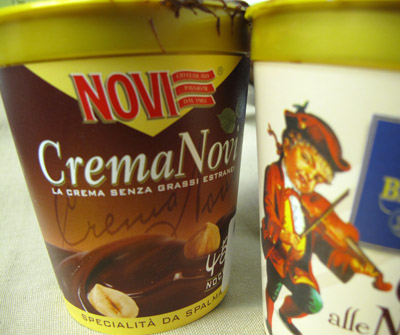 As with the gianduiotti produced by Baratti & Milano and Novi, these spreads do fair credit to the gianduia tradition, despite some economizing compromises. The cost-cutting may be attractive to some consumers, however. These spreads cost less than any that follow, as we move up the quality ladder. But they’re also cheaper than any of the lower-ranking spreads described above, sometimes by more than half. Good quality and a great price make these strong picks for the value-conscious.
As with the gianduiotti produced by Baratti & Milano and Novi, these spreads do fair credit to the gianduia tradition, despite some economizing compromises. The cost-cutting may be attractive to some consumers, however. These spreads cost less than any that follow, as we move up the quality ladder. But they’re also cheaper than any of the lower-ranking spreads described above, sometimes by more than half. Good quality and a great price make these strong picks for the value-conscious.
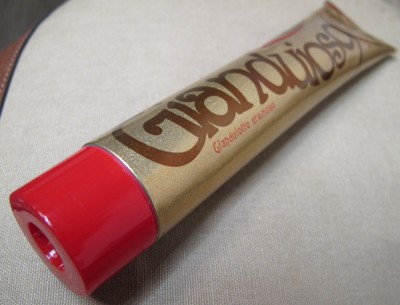 ★★ Leone, Gianduioso (Crema al Cioccolato alle Nocciole Gianduia) (15). Though originating in Alba (Piedmont) in the mid-nineteenth century, Leone has operated in Turin for nearly a century. Better known for hard caramels and a rainbow of pastilles (pastiglie), the now-sizable factory also produces a number of chocolate and gianduia products, including Gianduioso.
★★ Leone, Gianduioso (Crema al Cioccolato alle Nocciole Gianduia) (15). Though originating in Alba (Piedmont) in the mid-nineteenth century, Leone has operated in Turin for nearly a century. Better known for hard caramels and a rainbow of pastilles (pastiglie), the now-sizable factory also produces a number of chocolate and gianduia products, including Gianduioso.
As a dark chocolate gianduia spread, Gianduioso holds up well, having 45% hazelnut content (all Tonda Gentile delle Langhe) and no extraneous fats or artificial ingredients. It contains enough cocoa and cacao mass to avoid excessive sweetness. Despite the high hazelnut content, the texture isn’t as slick as that of some of the more refined spreads.
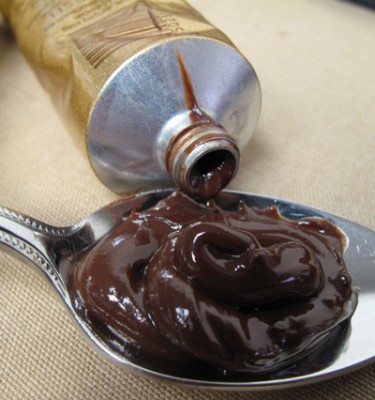 The most distinctive feature of Leone’s product lies in the packaging. Unlike other premium gianduia spreads sold in jars or tubs, Gianduioso comes in a toothpaste-like tube (16). This offers a degree of convenience, but does come at a cost. Gianduioso, like any premium gianduia spread, experiences separation of hazelnut oil from solid ingredients over time. While a jarred spread can easily be stirred to reincorporate the oil, Gianduioso’s tube makes this next to impossible. The first thing out of the tube often ends up being a significant amount of separated, intensely aromatic hazelnut oil, negatively impacting the flavor, aroma, and texture of the remainder. With 45% Piedmont hazelnuts as the starting point, though, Gianduioso can afford to lose some oil and still warrant recommendation.
The most distinctive feature of Leone’s product lies in the packaging. Unlike other premium gianduia spreads sold in jars or tubs, Gianduioso comes in a toothpaste-like tube (16). This offers a degree of convenience, but does come at a cost. Gianduioso, like any premium gianduia spread, experiences separation of hazelnut oil from solid ingredients over time. While a jarred spread can easily be stirred to reincorporate the oil, Gianduioso’s tube makes this next to impossible. The first thing out of the tube often ends up being a significant amount of separated, intensely aromatic hazelnut oil, negatively impacting the flavor, aroma, and texture of the remainder. With 45% Piedmont hazelnuts as the starting point, though, Gianduioso can afford to lose some oil and still warrant recommendation.

Amedei, Crema Toscana alla Nocciola
★★ Amedei, Crema Toscana alla Nocciola (17). Well into the premium single-origin bean-to-bar chocolate revolution, Tuscany-based Amedei (Cecilia and Alessio Tessieri) remains on most connoisseurs’ short list of the world’s best chocolate makers. Consistent with the company’s reputation, the ingredient list for their Crema Toscana alla Nocciola withstands the highest scrutiny, with high Tonda Gentile delle Langhe hazelnut content (47%), natural vanilla, and no extraneous fats or artificial flavors.
Those familiar with Amedei’s few milk chocolate and gianduia bars will find the flavor balance of this spread familiar. Hazelnut and a sweet, caramelized milkiness (accented with vanilla), cast a shadow over the chocolate. It’s like a photo negative of Venchi’s Cuor di Cacao.
The high hazelnut content maintains a velvety, mouth-coating quality typical of good gianduia. Textural consistency has varied harmlessly, with some batches slightly fluid and others having a light, creamy “whipped” quality. In all, this is a worthy interpretation of gianduia, stamped with Amedei’s distinctive house style.
Three Stars (★★★).
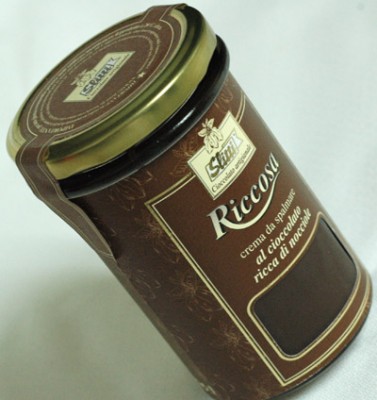 ★★★ Slitti, Riccosa (18). Slitti’s Riccosa improves on Nocciolata in a number of important ways. It doesn’t include extraneous vegetable fats. It has significantly higher hazelnut content (46%), though still Tonda Gentile delle Langhe. It uses natural vanilla, instead of vanillin. The ingredient list shows a recommitment to quality.
★★★ Slitti, Riccosa (18). Slitti’s Riccosa improves on Nocciolata in a number of important ways. It doesn’t include extraneous vegetable fats. It has significantly higher hazelnut content (46%), though still Tonda Gentile delle Langhe. It uses natural vanilla, instead of vanillin. The ingredient list shows a recommitment to quality.
The results are excellent. Riccosa approaches Nutella in smoothness and spreadability, but with far greater intensity of flavor and aroma. Though the vanilla is more pronounced than in most Piedmontese spreads (typical of Tuscan interpretations of gianduia), the balance of hazelnut, milk chocolate, and sugar falls right in the strike zone.
 ★★★ La Molina, Crema Gianduia Scura (19). La Molina is a small Tuscan confectioner in Quarrata (about five miles from where Slitti operates). The ingredient list of this dark chocolate gianduia spread offers no room for criticism. It follows all of the guidelines.
★★★ La Molina, Crema Gianduia Scura (19). La Molina is a small Tuscan confectioner in Quarrata (about five miles from where Slitti operates). The ingredient list of this dark chocolate gianduia spread offers no room for criticism. It follows all of the guidelines.
At 55%, La Molina’s spread has higher hazelnut content than any other I’ve seen in the United States (20). This produces the most powerful hazelnut aroma and flavor of any of the spreads in this report. The high hazelnut content also gives the spread a lush, velvety, mouth-coating texture.
Though a dark chocolate gianduia spread, the hazelnut content subdues the chocolate flavor, almost to a fault. La Molina presses up against the border between gianduia and hazelnut butter. Even so, this is an exceptional spread.
 ★★★ Amedei, Crema Toscana al Cacao (21). Concurrently with Amedei’s replacement of its “Crema Toscana” with Crema Toscana alla Nocciola, the Tuscan chocolate-maker launched this dark chocolate gianduia spread. As with Amedei’s other spread, this product contains only premium ingredients: high hazelnut content of 50% (all Tonda Gentile delle Langhe), cacao mass and cocoa of their own making, cane sugar, and natural vanilla.
★★★ Amedei, Crema Toscana al Cacao (21). Concurrently with Amedei’s replacement of its “Crema Toscana” with Crema Toscana alla Nocciola, the Tuscan chocolate-maker launched this dark chocolate gianduia spread. As with Amedei’s other spread, this product contains only premium ingredients: high hazelnut content of 50% (all Tonda Gentile delle Langhe), cacao mass and cocoa of their own making, cane sugar, and natural vanilla.
Amedei’s dark gianduia spread maintains a slightly dense, but creamy consistency. It’s easily spreadable, though liquefies quickly on warm bread. Despite the fifty percent hazelnut content, the dark chocolate flavor comes through clearly and complementarily. (The cacao is not “in your face,” as with Askinosie’s spread or Venchi’s Cuor di Cacao.) Though at the darker end of the gianduiotti spectrum, the flavor balance still falls within the gianduia tradition. A heavy hand with the vanilla mucks up the taste and aroma a bit, but not enough to keep Crema Toscana al Cacao from scoring high marks.
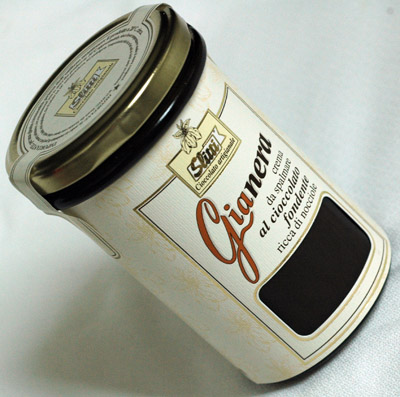 ★★★ Slitti, Gianera (22). Unlike Slitti’s Riccosa, Nocciolata, and Slittosa, Gianera is a dark chocolate gianduia spread. Like Riccosa, Gianera avoids all of the compromises of the older Nocciolata and Slittosa products, eliminating extraneous vegetable fats, dialing up the Tonda Gentile delle Langhe content to 52%, and replacing vanillin with natural vanilla.
★★★ Slitti, Gianera (22). Unlike Slitti’s Riccosa, Nocciolata, and Slittosa, Gianera is a dark chocolate gianduia spread. Like Riccosa, Gianera avoids all of the compromises of the older Nocciolata and Slittosa products, eliminating extraneous vegetable fats, dialing up the Tonda Gentile delle Langhe content to 52%, and replacing vanillin with natural vanilla.
The high content of quality hazelnuts delivers a strong, sweet aroma, fast melt, and velvety, mouth-coating texture. Chocolate flavor edges to the fore, despite the high hazelnut content, but does not dominate. The balance tilts darker than most (though not all) dark chocolate gianduiotti. As with most of the Tuscan spreads, there’s more than a hint of vanilla (though not so much as Amedei’s). This excellent spread is harder to find in the United States than most on this list, but is well worth the dollars if you spot it (23).
 ★★★ Guido Gobino, Crema Spalmabile Gianduja (24). Turin-based Guido Gobino ranks among the modern masters of gianduia. His extruded gianduiotti, intense and well-balanced, are some of the best on the market. This recent reformulation of his gianduia spread strengthens his reputation for quality. Gobino’s crema follows nearly all of the rules. It has strong hazelnut content (35%, a slight improvement over his preceding version of the spread), all Tonda Gentile delle Langhe, and no artificial flavors or extraneous fats. The spread has only one significant flaw. High sugar content, though counterbalanced by the cacao, produces a tacky texture that comes closer to Nutella than to the velvety feel of gianduia.
★★★ Guido Gobino, Crema Spalmabile Gianduja (24). Turin-based Guido Gobino ranks among the modern masters of gianduia. His extruded gianduiotti, intense and well-balanced, are some of the best on the market. This recent reformulation of his gianduia spread strengthens his reputation for quality. Gobino’s crema follows nearly all of the rules. It has strong hazelnut content (35%, a slight improvement over his preceding version of the spread), all Tonda Gentile delle Langhe, and no artificial flavors or extraneous fats. The spread has only one significant flaw. High sugar content, though counterbalanced by the cacao, produces a tacky texture that comes closer to Nutella than to the velvety feel of gianduia.
The flavor balance approaches that of Gobino’s Tourinot gianduiotti—an ideal goal for a milk-chocolate gianduia spread. This is an excellent product, by any measure, though a modest boost in hazelnut and cacao to drive down the sugar content would take it to even greater heights.
 ★★★ Caffarel, Crema Gianduia 40% (25). With this spread, Caffarel lives up to its iconic status and deep historical roots in Piedmont, upgrading the old Crema Gianduja al Latte in every respect. Caffarel took the hazelnut content from a Ferreroesque 14% to a sturdy 40%. They swapped cheaper Turkish hazelnuts for premium Tonda Gentile delle Langhe. They eliminated superfluous vegetable fats. They dropped vanillin. They even improved the packaging, employing the Gothic logo Caffarel began using in 1937 and placing an image of the character Gianduia on the lid (holding an oversized Caffarel gianduiotto, no less).
★★★ Caffarel, Crema Gianduia 40% (25). With this spread, Caffarel lives up to its iconic status and deep historical roots in Piedmont, upgrading the old Crema Gianduja al Latte in every respect. Caffarel took the hazelnut content from a Ferreroesque 14% to a sturdy 40%. They swapped cheaper Turkish hazelnuts for premium Tonda Gentile delle Langhe. They eliminated superfluous vegetable fats. They dropped vanillin. They even improved the packaging, employing the Gothic logo Caffarel began using in 1937 and placing an image of the character Gianduia on the lid (holding an oversized Caffarel gianduiotto, no less).
 The results are stunning. Of all the spreads readily available in the United States, Caffarel’s Crema Gianduia 40% comes closest to capturing the experience of “gianduiotti in a jar.” Sweet, intense Piedmont hazelnuts grab hold in the initial aroma and carry all the way through into a clean aftertaste, unmarred by excessive sugar or vanilla. Milk chocolate flavor meshes neatly, neither dominating nor fading entirely under the hazelnuts. In truth, this spread quite surpasses Caffarel’s signature gianduiotti (with their 28% non-TGL hazelnut content and vanillin). Highly recommended.
The results are stunning. Of all the spreads readily available in the United States, Caffarel’s Crema Gianduia 40% comes closest to capturing the experience of “gianduiotti in a jar.” Sweet, intense Piedmont hazelnuts grab hold in the initial aroma and carry all the way through into a clean aftertaste, unmarred by excessive sugar or vanilla. Milk chocolate flavor meshes neatly, neither dominating nor fading entirely under the hazelnuts. In truth, this spread quite surpasses Caffarel’s signature gianduiotti (with their 28% non-TGL hazelnut content and vanillin). Highly recommended.
Notes:
(1) Ingredients listed (Scharffen Berger, Gianduja): Sugar, cacao beans, half-and-half (milk), hazelnuts, corn syrup, and whole vanilla beans.
(2) Ingredients listed (Askinosie, “Hey, Hey, Hazelnut!”): Hazelnuts (oil and butter), cocoa powder, organic sugar, roasted cocoa nibs. In direct correspondence, Shawn Askinosie said hazelnut content (not including added hazelnut oil) is a minimum 20%.
(3) Cristofori, Valerio. Fattori di Qualità della Nocciola. Tesi di Dottorato di Ricerca. Università degli Studi Tuscia di Viterbo, Dipartimento di Produzione Vegetale, Sezione Ortofloroarboricoltura. 2005. Pp. 123, 129, 135-6.
(4) Ingredients listed (Venchi, No Sugar Added): Maltitol, Piedmont hazelnut paste I.G.P. (16%), vegetable fat, cocoa powder (22-24% cocoa butter), cocoa powder (10-13% cocoa butter), whole milk powder, skim milk powder, soy lecithin.
(5) Ingredients listed (Caffarel, Crema Gianduja al Latte): Sugar, hazelnuts (14%), skim milk powder (10%), peanut oil, vegetable fat, low-fat cocoa powder (6%), almonds, soy lecithin, vanillin.
(6) Ingredients listed (Venchi, Crema di Cacao): Sugar, Piedmont hazelnut paste I.G.P. (13%), vegetable oil, skim milk powder, cocoa powder (22-24% cocoa butter), cocoa powder (10-12% cocoa butter), soy lecithin, flavored with natural vanilla
(7) Ingredients listed (Venchi, Crema al Cacao e Nocciole): Sugar, Piedmont hazelnut paste I.G.P. (17%), olive oil (17%), low fat cocoa powder (12.8%), skim milk powder, soy lecithin, natural vanilla flavor.
(8) Ingredients listed (Giraudi, Giacometta): Sugar, Piedmont hazelnuts I.G.P. (32%), peanut oil, low-fat cocoa powder, almonds, powdered whole milk, soy lecithin, natural flavors: vanillin.
(9) Ingredients listed (Slitti, Nocciolata): Sugar, Piedmont hazelnuts I.G.P. (35%), milk, cocoa powder, vegetable fat, vanillin, soy lecithin.
(10) Ingredients listed (Domori, Crema Gianduja): Piedmont hazelnut paste I.G.P. (50%), cane sugar, cocoa powder, natural vanilla extract, soy lecithin.
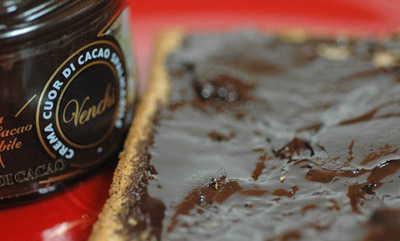
Venchi’s prior Cuor di Cacao, with 40% hazelnut content
(11) Ingredients listed (Venchi, Crema Cuor di Cacao): Sugar, low fat cocoa butter, Piedmont hazelnut paste (23%), olive oil, soy lecithin, natural vanilla flavor.
(12) Ingredients listed for discontinued version of Venchi, Crema Cuor di Cacao: Piedmont hazelnut paste (40%), sugar, cocoa powder (22-24% cocoa butter), cocoa mass, cocoa butter, soy lecithin, natural vanilla.
(13) Ingredients listed (Baratti & Milano, Crema alle Nocciole): Hazelnuts (45%), sugar, fat reduced cocoa powder (9%), skim milk powder (5%), cocoa butter, soy lecithin, flavoring.
(14) Ingredients listed (Novi, CremaNovi): Hazelnuts (45%), sugar, fat reduced cocoa powder (9%), skim milk powder (5%), cocoa butter, soy lecithin, flavoring.
(15) Ingredients listed (Leone, Gianduioso): Piedmont hazelnuts I.G.P. (45%), sugar, cocoa, cacao mass, natural vanilla pods, non-GMO soy lecithin.
(16) This isn’t quite the novelty that it may seem. Caffarel & Prochet sold chocolate paste in foil tubes—Crema Supra (L’Elefante Goloso)—in the 1930s, even predating Ferrero’s spreadable Supercrema by decades.

Amedei’s prior Crema Toscana
(17) Ingredients listed (Amedei, Crema Toscana alla Nocciola): Piedmont hazelnuts I.G.P. (47% minimum), cane sugar, skim milk powder, cocoa mass, cocoa, vanilla. This spread replaces the former “Crema Toscana,” which despite a different name and different packaging, had an identical ingredient list.
(18) Ingredients listed (Slitti, Riccosa): Piedmont hazelnuts I.G.P. (46%), sugar, whole milk powder, cocoa butter, cocoa, cocoa mass, natural vanilla. (Cocoa minimum 14%.)
(19) Ingredients listed (La Molina, Crema Gianduia Scura): Piedmont hazelnuts I.G.P. (55%), sugar, cocoa butter, cocoa powder, natural vanilla.

Castagna Crema CQ with grissino
(20) Though rarely, some in Piedmont go even higher—notably, Guido Castagna’s extraordinary Crema +55. The name is jab at Nutella, indicating that Castagna’s spread adds 55 to Ferrero’s 13% hazelnut content, for a total of 68%. Castagna takes another kick at Ferrero’s shins with Crema CQ, a spread with 12% hazelnut content—one percent less than Nutella—but that delivers surprisingly intense flavor and aroma through the use of Tonda Gentile delle Langhe hazelnuts and flavor cacao.
(21) Ingredients listed (Amedei, Crema Toscana al Cacao): Piedmont hazelnuts I.G.P. (50% minimum), cane sugar, cacao mass, cocoa, vanilla.
 (22) Ingredients listed (Slitti, Gianera): Piedmont hazelnuts I.G.P. (52%), sugar, cocoa mass, low-fat cocoa powder, cocoa butter, natural vanilla. (Cocoa minimum 20%.)
(22) Ingredients listed (Slitti, Gianera): Piedmont hazelnuts I.G.P. (52%), sugar, cocoa mass, low-fat cocoa powder, cocoa butter, natural vanilla. (Cocoa minimum 20%.)
(23) When I was struggling to find the Slitti spreads in the U.S. in late 2008, Michael Magnatta of TusCan International (a Canadian importer) graciously agreed to sell me a case of them, despite the hassle of getting it through Customs.
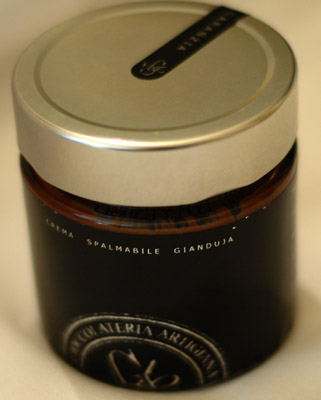
Gobino’s discontinued Crema Spalmabile Gianduja
(24) Ingredients listed (Guido Gobino, Crema Spalmabile Gianduja): Sugar, Piedmont hazelnuts I.G.P. (35%), low-fat cocoa powder, skim milk powder, concentrated butter, natural extract of Bourbon vanilla, non-GMO soy lecithin.
(25) Ingredients listed (Caffarel, Crema Gianduia 40%): Piedmont hazelnuts I.G.P. (40%), sugar, low-fat cocoa powder, skim milk powder, concentrated butter, almonds, soy lecithin. For discussion of Caffarel’s use of almonds in gianduia, see Rule #7 (and accompanying notes) in the Decalogue for Gianduia Snobs.
